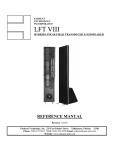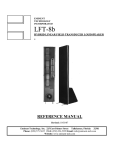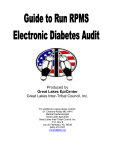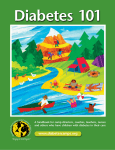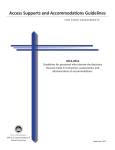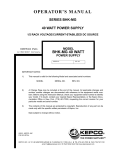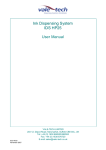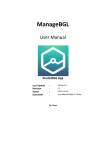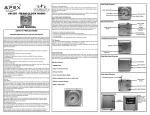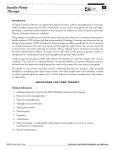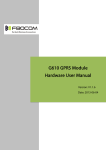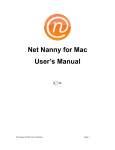Download Diabetes Care Guide Book - Hackensack University Medical Center
Transcript
! THE JOSEPH M. SANZARI CHILDREN’S HOSPITAL ------------------------------------------------------------------------------ The MOLLY Center for Children with Diabetes and Endocrine Disorders DON IMUS-WFAN Pediatric Center PC 251 Hackensack NJ 07601 201-996-5329 Office 201-525-0115 Fax 201-996-3436 Nutrition Office 201-996-5342 Child Life Office [email protected] ! The MOLLY Diabetes Education/Management Center at Hackensack University Medical Center 211 Essex Street, Suite 101 Hackensack, NJ 07601 201-968-0585 Office 201-968-0586 Fax ! ! ! ! “Hackensack University Medical Center is pleased to provide access to the resource material contained herein. This material is provided for informational use only and is not intended to be medical advice. It is important that you discuss any questions you may have with your physician or healthcare provider.” ! ! !1 TABLE OF CONTENTS I. ! II. ! ! GENERAL INFORMATION_________________________3 FOOD AND NUTRITION__________________________7 III. INSULIN A) Types of Insulin______________________________8 B) Insulin Preparation and Injection________________10 C) Insulin Pumps_______________________________16 IV. ! V. ! VI. ! ORAL DIABETES MEDICATIONS__________________17 BLOOD GLUCOSE MONITORING__________________ 18 KETONE TESTING_____________________________ 24 VII. SPECIAL TOPICS A) Balancing Your Blood Sugar 1. Hypoglycemia (low blood sugar) ______________25 2. Hyperglycemia (high blood sugar)_____________29 3. Diabetic Ketoacidosis______________________31 B) Physical Activity and Exercise__________________33 C) Emergency Identification______________________36 D) Sick Day Guidelines__________________________36 ! VIII. EMOTIONAL ADJUSTMENT TO DIABETES_________ 38 ! IX. SCHOOL AND DIABETES_______________________ 39 ! X. RESOURCES FOR DIABETES MANAGEMENT_________40 ! APPENDIX A) Food and Activity Records B) Blood Glucose/Medication Log Sheets C) School Letter and Guidelines D) School Nurse Order Form E) Insulin Dosing Guidelines F) “Diabetes Care Guide” Questionnaire ! ! !2 ! DIABETES CARE GUIDE FOR CHILDREN WITH DIABETES GENERAL INFORMATION Introduction ! ! When you first find out that you or your child has diabetes it is natural to have many different feelings. You may be shocked, afraid, and a bit confused. You may also feel overwhelmed by the thought of having to learn so many new things. This booklet is designed to give you basic information about how to care for yourself or a child with diabetes. Your healthcare team will review this information with you so that you can feel comfortable as an active participant in your care. ! This booklet is only a beginning to your learning process. We encourage you to continue to learn more about diabetes. Your diabetes healthcare team can provide you with the resources and ongoing education in order to do so. ! Although there is no cure for diabetes yet, the good news is that diabetes can be treated and controlled. With the help of supportive families and good healthcare, children and adults with diabetes can lead healthy, fun-filled lives. ! ! What Is Diabetes? ! Diabetes is a life-long disorder in which the body cannot use food properly because of a lack of effective insulin. Normally when food is eaten, it is digested and turned into a sugar called glucose. Glucose is then carried in the blood to our body cells to be used as energy. Glucose needs insulin to help it travel from our blood into our cells. Insulin’s job is to regulate how the body uses glucose. Insulin is made in a part of our body called the pancreas. ! ! NORMAL DIGESTION ! Food is eaten !3 ! Food is digested in the stomach and intestines and is turned into glucose ! Blood glucose level increases ! Pancreas releases insulin ! Insulin helps glucose enter the cells of the body Glucose is used for energy ! ! Some glucose is stored Blood glucose level decreases ! ! Pancreas releases less insulin ! ! When a person has diabetes, the body does not have insulin to carry glucose to the cells. If glucose cannot enter the cells where it is needed for energy, it builds up in the blood instead, causing a high blood glucose level. This is called hyperglycemia. Hyperglycemia may cause a person to experience some of the following symptoms. ! • Signs and Symptoms of Hyperglycemia 1. Excessive hunger 2. Excessive urination (The kidneys are trying to get rid of excess sugar.) 3. Excessive thirst (The body needs more fluids because of increased urination.) 4. Weight loss (The body breaks down fat for energy when glucose cannot be used. There may also be significant fluid loss from increased urination.) 5. Fatigue 6. Vision changes - blurring, fuzziness (The shape of the eye changes because of prolonged high blood sugar and changes in fluid level.) 7. Irritability or behavioral changes 8. Flushing of skin !4 9. Recurring vaginal infections, skin rashes, or slow healing wounds ! ! Types Of Diabetes ! The two main types of diabetes are type 1, or immune-mediated (formerly called insulin-dependent diabetes); type 2, (formerly called non-insulindependent diabetes). ! Children and young adults usually have type 1 diabetes, in which the pancreas makes little or no insulin. Without insulin, the body cannot control blood levels of sugar, so people with type 1 diabetes need to take insulin injections every day. ! Type 2 diabetes is the most common type of diabetes. People with type 2 diabetes usually produce some insulin, but the body cannot use it efficiently. While this type of diabetes usually develops in adults over the age of 40, it accounts for at least 10 percent of diabetes diagnosed in children in this country. ! ! What Causes Diabetes? ! We do not know exactly what causes diabetes. We know that people inherit a tendency to get diabetes, but not all people who have this tendency will get the disease. We also know that you cannot “catch” diabetes like a cold. Eating too much sugar does not cause it, either. ! ! Methods Of Control That Help Manage Diabetes ! The goals of treatment for diabetes in children include maintaining normal growth and development, keeping blood glucose levels within a target range as much as possible, and promoting healthy emotional well-being. Blood sugar levels can be maintained within a target range by balancing insulin, food, and physical activity. (Food raises blood glucose levels; insulin and physical activity lower them.) ! A diabetes treatment plan includes eating a balanced diet on a consistent schedule, monitoring blood glucose levels throughout the day, adjusting !5 medication as blood glucose levels and physical activity warrant (in consultation with your diabetes healthcare team), and taking part in physical activity regularly. ! Diabetes treatment plans have changed in recent years and are now more flexible than they had been in the past. Current treatment now places more emphasis on individual lifestyle differences and attempts to meet the needs of each person and his or her family. ! ! Honeymoon Period ! Within a few weeks of beginning treatment for type 1 diabetes, many people may experience what is called the honeymoon period. It usually starts within two to eight weeks, although not all people will have this honeymoon period. During the honeymoon period, the pancreas is still making some insulin. The body may not need much extra insulin during this time, although the person still has diabetes. This period usually lasts one to three months. After the honeymoon period is over, the body will need more insulin again. We advise our patients to continue taking insulin during the honeymoon period, although they may only take a very small amount. In this way, a person who has diabetes will know that they must always remember to take their insulin everyday. You will need to be in contact with your diabetes healthcare team frequently when the honeymoon period starts. Insulin doses will need to be lowered immediately to prevent very low blood sugars due to too much insulin. !! ! ! !6 FOOD AND NUTRITION ! Children with diabetes have the same nutritional needs as children who do not have diabetes. The goals of healthy eating are to promote growth, maintain a desirable body weight, and to feel well. There is a need to balance your insulin with your food intake and physical activity. ! Carbohydrate counting is a method used by many people with diabetes. It is effective because carbohydrates are the main nutrient in food that affects blood glucose levels. Children with diabetes will learn to “cover” or match the carbohydrates eaten at a meal or snack. Using Lantus (or Levemir) and Novolog (or Humalog) allows for flexibility with meals and snacks. For example, children can skip breakfast and eat brunch with their family on weekends if they choose. There is no need to eat at certain times of the day. We want children with diabetes to follow the same schedule as the rest of the family. ! Sometimes children who have been recently diagnosed with type 1 diabetes are very hungry. They should be allowed to eat to satisfy their hunger and regain weight lost before diagnosis. After a few weeks, these children usually regain the weight and return to previous eating habits. ! You will meet with a Registered Dietitian (RD) who will help you learn to count carbohydrates and give specific recommendations for your child and his/her lifestyle. ! It is helpful to use a Food and Activity Record to keep track of food and activity and their effects on blood glucose levels. A sample and blank Food and Activity Records are provided in the back of this booklet. Please copy and use these records. These records will also be helpful to you when you speak with the dietitian about your meal plan. ! ! ! !7 ! INSULIN Insulin is a hormone that attaches to the cells in our bodies and allows glucose to move from the blood into our cells to be used for energy. Children with type 1 diabetes do not make insulin, which is why they always require insulin injections to control their diabetes. Children with type 2 diabetes still make insulin, but it does not work very well. If ketones are present at the time of diagnosis, these children will also require insulin. Some children with type 2 diabetes may be able to take oral diabetes medication instead of insulin. It is important to realize that these children with type 2 diabetes may need to take insulin again, especially during times of illness or inadequate blood glucose control. ! Insulin must by injected into the body; it cannot be taken orally. Most children who take insulin take one injection of long acting insulin a day (Lantus) plus additional injections of rapid acting insulin with each meal/snack. However, some children take two to three injections a day at the same time each day. Other children may use an insulin pump for a continuous infusion of insulin throughout the day. Using Lantus plus rapid acting insulin or an insulin pump allows for greater flexibility in both the timing and amounts of food eaten. Regardless of which insulin schedule you use, the goal is to keep blood sugars as balanced as possible throughout the day, not too high and not too low. ! ! TYPES OF INSULIN ! Children with diabetes will usually be using different types of insulin. Each type of insulin has a different action time. When insulin is injected beneath the skin, it takes time for it to be absorbed into the bloodstream and to reach the cells where it acts. The type of insulin will determine how soon it will start to work and how long its effects will last. ! There are four major types of insulin, each differing in: 1. Onset – the time the medication begins working 2. Peak – the time the medication is working the most 3. Duration – how long the medication lasts after it is injected ! ! !8 The four types of insulin are categorized according to their action times: 1. Rapid Acting (clear) – “Humalog,” “Novolog,” “Aphidra” 2. Short Acting (clear) – “Regular” 3. Intermediate Acting (cloudy) – “NPH,” “Lente” 4. Basal Insulin (clear) – “Lantus,” “Levemir” ! The table below represents typical action times. It is important to note that duration of action can vary substantially from child to child and from one injection to the next. Variations of action times also occur with different manufacturing companies. ! ! Name Humalog Letter H Novolog Onset Peak Duration 5 - 15 min 1 hour 2 - 4 hrs 5 - 15 min 1 hour 2 - 4 hrs Regular R 30 min - 1 hr 2 - 5 hrs 6 - 16 hrs NPH N 1 - 2 hrs 4 - 12 hrs 24+ hrs Lente L 1 - 3 hrs 6 - 15 hrs 22+ hrs Ultralente U 4 - 6 hrs 8 - 30 hrs 36+ hrs Lantus 45 min-2 hrs Does not peak up to 24 hrs Levemir 3-6 hrs Does not peak up to 23 hrs ! Novolog and Humalog should be given right before the meal. However, for toddlers or when unsure of amount to be eaten, give within 15-30 minutes of when a child starts eating - this helps to prevent hypoglycemia if the entire meal is not eaten. ! You and your doctor will decide which insulin(s) are best for you. You should not change the type or brand of insulin without first consulting your doctor. You should not mix two different brands of insulin. The amount of insulin taken daily is based on several factors, including a person’s weight, activity level, food intake, and blood sugar reading. The dose of long-acting insulin is usually kept constant from day to day. The !9 dose of short-acting insulin is usually given depending on what the blood sugar reading is before that injection and depending on how many grams of carbohydrate are to be eaten. The dose of insulin may need to be decreased if a person will be physically active at the time the insulin is peaking. Your doctor will give you an insulin dose schedule to follow. He/ she will also give guidelines as to when to call for an insulin dose change. Eventually you will learn to make insulin adjustments on your own. ! INSULIN PREPARATION AND INJECTION ! Syringes Syringes come in various sizes with varying needle widths and lengths. Be sure to discuss this with your healthcare provider so that you can help choose the best syringe and needle for your needs. It will be easier to draw up the insulin correctly if you use the smallest syringe that will hold the dose of insulin. The injection will be more comfortable and effective when the needle length is right for you. ! The most common sizes are: • 1 cc - holds up to 100 units • 1/2 cc - holds up to 50 units • 1/3 cc - holds up to 30 units ! ! The syringe concentration is marked on each syringe. Remember to use a syringe and insulin with the same concentration. You will most likely be using U-100 insulin, so that you will need to use U-100 syringes. ! There are three parts to an insulin syringe: 1. Needle 2. Barrel 3. Plunger !10 ! The unit measurements are located on the barrel of the syringe. Most syringes are marked in one-unit increments. Syringes marked in ½-unit increments are also available. If your insulin dose is in ½ unit increments, ask your doctor to specify this on your syringe prescription. ! In most states, including New Jersey, you need a prescription from your physician to purchase insulin syringes. Syringes should be stored in a safe place, out of reach of children, and should only be taken out for injections. Before discarding the syringe, the needle can be clipped off with a special needle cutter designed for this purpose. Syringes, unclipped needles, and lancets should be discarded after each use in a “sharps” container. A “sharps” container can be any puncture-proof, non-recyclable container such as a thick plastic detergent container. This will prevent any accidental puncture injury. Ask your local health department how to dispose of the full containers because there may be local regulations. Pens Components: Pen (with and without cartridge), pen needles Parts of the pen: Barrel, dial, pen needle, cover Insulin Pen Types There are 2 major categories of insulin pens: reusable pens and disposable pens. • Reusable insulin pens must be loaded with a cartridge of insulin before using (sold separately in boxes of five cartridges). Cartridges typically hold 150 or 300 units of insulin. Depending on the size of your doses, a cartridge may give you enough insulin to last for several days of injections. When the cartridge is empty, you throw it away and load a new cartridge. With good care, a reusable pen can often be used for several years. • Disposable insulin pens come filled with insulin and are thrown away when they are empty. Most disposable pens used in the U.S. today hold 300 units of insulin and are sold in boxes of five. Pen needles must be changed after each time you inject! ! " !11 " " ! Insulin Preparation ! Most of the time you will use only one type of insulin per dose. When using Lantus or Levemir insulin, no other insulin can be mixed in the same syringe. Your healthcare provider will provide you with instructions on how to draw up and inject your insulin correctly. (See handouts on Drawing Up Insulin for diagrams.) ! How to Draw Up One Type of Insulin 1. Wash your hands with soap and water. 2. Gather supplies: Insulin, insulin syringe, and alcohol swab. 3. If using cloudy insulin, gently roll or turn the vial up and down (rotate) 20 times to mix, making sure that there are no insulin crystals at the bottom. (Do this step immediately before drawing up this insulin. Do not shake the vial, which might cause damage to the insulin or introduce air bubbles into the solution.) 4. Clean top of insulin vial with alcohol swab. 5. Remove the needle cover and draw air into the syringe until the end of the plunger is in line with the desired dose. ________Units 6. Insert the needle through the stopper and inject air into the vial. 7. Turn vial of insulin upside down and pull plunger back on syringe to the prescribed dose. ________Units 8. Check for air bubbles. If air bubbles are present, tap the syringe with your finger or a pen to make the bubbles float to the top. Inject bubble into the bottle. Pull plunger back again to desired dose. You may also choose to inject all the insulin back into the vial. Repeat steps 7 and 8 until all large bubbles are gone. ! If you have difficulty seeing the numbers on the syringe, there are numerous !12 products available to magnify them for you. This will enlarge the numbers on the syringe so that you can better draw up the correct dose. ! Injection Sites ! Possible injection sites are shown on the diagram below. Each area of the body absorbs insulin into the blood at a slightly different rate. Insulin is absorbed fastest from the abdomen, slower from the arms and legs, and slowest from the buttocks. For this reason, it is recommended that injection sites be rotated and injected within a single area at the same time of day. It is a good idea to work out a schedule for rotating injections. For example, morning shot in the arm, suppertime shot in the leg, and bedtime shot in the buttocks, or morning shot in the abdomen, suppertime shot in the arm or leg, and bedtime shot in the buttocks. Rotation of sites is also recommended to prevent thickening of skin area and to prevent excessive fat deposits (hypertrophy), or dimpling (atrophy) due to repeated use of the same site. Your goal in rotating injection sites is consistent and reliable absorption of insulin. ! ! ! ! " ! Insulin Injection 1. Select site for injection. 2. Make sure the site is clean. !13 3. Carefully remove the needle cap. 4. With one hand, gently pinch up a fold of skin between your thumb and index finger. 5. Using the other hand, hold the syringe like a dart and gently push the needle straight into the skin with one steady motion. The angle at which you insert the needle will depend on the length of the needle and the amount of fat at the site. Generally, when using the 5/16 (short) needle you will inject at a 90-degree angle. If you are using a ½ long needle, you may need to use a 45degree angle. (Your doctor or nurse will show you how to best inject your insulin at different sites.) 6. Push the plunger down to inject all the insulin into the site. Wait 5-10 seconds. 7. Release the skin, withdraw the needle and immediately place the alcohol swab over the injection site. You may press lightly, but do not rub area. 8. Safely dispose of the needle and syringe as discussed earlier. 9. Record the dosage of insulin and site of injection in your record book. ! Insulin may be injected with a needle and syringe, an insulin pen, an insulin pump, or with a needle-free injector. There are also devices that you can place a needle and syringe inside of so that the needle is hidden and the needle insertion is done automatically. Ask your nurse about these devices if you are interested. ! There is no specific age when children are ready to give their own insulin injections. However, regardless of when a child begins giving their own injections, they should always have an adult’s supervision. ! Purchasing Insulin When purchasing insulin here are a few things to remember: • Check the name, type, brand, color, concentration, and expiration date on the bottle. • Do not accept any insulin that is stringy in appearance or has lumps that float or stick to the sides of the bottle. • Buy an extra bottle of each type of insulin in case a bottle is broken or lost so that you will have another bottle available. • In many states, insulin is a nonprescription drug. However, a prescription may be necessary for reimbursement from a pharmaceutical plan. !! Storing Insulin !14 • Insulin in vials should be kept under refrigerated conditions whenever possible. Do not freeze. • Insulin should be kept at room temperature for approximately 30 minutes before use to ensure better absorption. • Most insulins can be kept up to 28 days at room temperature. However, it may lose its strength if exposed to direct sunlight or extreme temperatures (less than 32° or greater than 86° F). Discard any insulin that has been exposed to extreme heat, cold, or direct sunlight. For travel, it is best to keep insulin in an insulated bag for protection. • Keep an extra bottle of insulin in the refrigerator. Unopened insulin can be kept up until the expiration date. • Other types of insulin, if normally cloudy, should be without clumps and should look like skim milk after mixing. • Insulin pens should be kept at room temperature once you start using them. ! ! ! !15 INSULIN PUMPS ! Another way to get insulin into the body is with an insulin pump. An insulin pump is a small computer (about the size of a beeper) that is programmed according to how much insulin is needed by a person’s body. The pump gives a steady flow of insulin except for when it is told by the pumper to give more, such as at mealtimes, and when blood glucose is too high. Insulin doses can be easily adjusted to match what a person does and to what he/she eats each day. When an insulin pump is used, a small needle is inserted under the skin. The needle is connected to tubing which leads to the pump. The needle delivering the insulin needs to be changed every two days. Pumps have to be worn at all times, except for bathing and swimming and brief periods when the pump might be damaged if worn. Insulin pumps do not check blood sugars. In fact, most pumpers check their blood glucose more often than they did when they used syringes. It takes time and practice to learn how to use a pump well, but many people feel the advantages are worth the extra work. Speak with your healthcare provider for more information about insulin pumps. You should also check with your insurance carrier to find out if an insulin pump would be covered by your plan. ! ! ! ! ! !16 ! ORAL DIABETES MEDICATION Children with type 1 diabetes are not treated with oral medications. Children with type 2 diabetes may need to take oral diabetes medications if they cannot meet their target blood glucose levels with a meal plan and physical activity. They may take an oral medicine alone, or in combination with insulin. There are several types of oral medications and they each work differently. The most commonly used oral medications for children are Glucophage and Glucophage XR (metformin). ! Metformin works by keeping the liver from releasing too much glucose. It helps to keep blood glucose from going too high throughout the day and night. Metformin may also help with weight loss. ! The main side effect of metformin is upset stomach, diarrhea, vomiting and bloating. It is important to know that lactic acidosis is a rare side effect that can occur if metformin is not stopped when a person has the stomach flu or a severe illness. It can also happen during an X-ray when dyes are used, and during episodes of vomiting, diarrhea, and pneumonia or with lung diseases. Metformin needs to be stopped during times of surgery, severe illness or with vomiting or diarrhea. Insulin will be substituted during these times until metformin can be restarted. Consult with your doctor or nurse if you have any questions regarding metformin use. ! The dose of metformin is usually started with 500 mg once daily and gradually increased over the next few weeks as needed and as tolerated by the child. The maximum dose of metformin for a child is 2500 mg per day. The upset stomach that some children may experience when they start taking metformin usually goes away after a week or so. ! ! ! ! ! ! ! ! ! BLOOD GLUCOSE MONITORING ! !17 ! Self-monitored blood glucose, (SMBG), is a very important part of controlling blood sugar. Monitoring and recording the results will help you and your healthcare team to discuss and manage your diabetes in the best possible way. Proper diabetes control may help to prevent some of the complications associated with diabetes. ! There are many products available to help you test blood glucose. Regardless of which meter you use, the basic principles for using each one are similar. In order to check your blood glucose level, you first prick a finger to obtain a drop of blood. You then place the drop of blood on a test strip, which is placed in the meter. The meter then reads the test strip and gives you a result. ! It is important to carefully read and follow the instructions for your meter before using it. You should also receive instruction on the proper technique from your healthcare provider before using the meter independently so that accurate results can be obtained. ! Tips For Monitoring Blood Glucose 1. Wash your hands and your child’s hands with warm water and soap. Dry thoroughly. This cleanses the skin and increases circulation to the fingertips. If you are unable to wash your hands, clean the fingertip to be pricked with an alcohol swab and let air-dry completely. 2. Assemble supplies needed before testing: Automatic lancing device, lancet (needle to prick finger), test strip, glucose meter, alcohol wipe, (if necessary), and cotton ball or tissue. 3. Massage or “milk” the finger to be pricked to bring blood to the fingertip. Point the hand down towards the floor. 4. Puncture the finger using the automatic pricking device. It is best to puncture the side of the fingertip as there is more blood and fewer nerve endings in these areas. If a large drop of blood does not form, gently “milk” the finger to push blood into the tip. 5. Place the blood on the test strip according to the manufacturer instructions. !! ! ! 6. Continue the test as indicated to obtain results. 7. Record results and time of test in the blood glucose logbook. ! It is also possible to obtain blood samples from other parts of your body using a !18 special type of lancet device or meter. Ask your diabetes educator to demonstrate these to you if you are interested. ! ! Blood Glucose Targets ! It is acceptable for children with newly diagnosed diabetes to have blood sugars that are above the target range for their age for the first days after diagnosis, as long as they do not have positive ketones in their urine or blood. Once the child returns to his/her normal routine of food and activity, the goal is to keep blood sugars in the target range. ! • If you are 6 years old or younger, your target is: 100-200 mg/dL before meals and before bedtime snack • If you are 6-12 years old, your target is: 80-180 mg/dL before meals and 100-180 mg/dL before bedtime snack less than 200 mg/dL, 2 hours after start of meal • If you are over 12 years old, your target is: 80-150 mg/dL before meals and 100-150 before mg/dL bedtime snack less than 200 mg/dL, 2 hours after start of meal ! • • !! You may need a different target range, so you should talk to your diabetes healthcare team about it. ! You may always have occasional blood sugars that are not in range. The important thing is to look for patterns of high or low blood sugars that happen at the same time of day. You should then speak with your healthcare team about adjusting the insulin to correct the problem until you are comfortable doing so yourself. If More Than Half of Your Blood Sugars Are In Your Target Range… CONGRATULATIONS…You Are In Good Control Of Your Diabetes! When Should You Check Blood Sugars? • At least four times/day; before each meal and before evening snack. ! • Before, during and after periods of exercise lasting more than 1 hour. ! !19 • Before driving, and periodically while driving long distances. ! Additional Times To Check Blood Sugar: • You feel signs of low or high blood sugar. ! • ! • ! You feel ill or stressed. Two hours after meals to check blood sugar control between meals. • If your schedule changes (increased physical activity, vacation, travel, job, school.) ! • ! • ! Between 12 - 2 a. m., if BG is less than 100 mg/dL before bedtime snack. At 3 a. m. at least weekly, or as directed by your doctor. • As directed by diabetes healthcare team when beginning pump initiation or more intensive management. (8-10x/day) ! ! REMEMBER TO WAIT AT LEAST TWO HOURS AFTER FOOD IS EATEN TO CHECK BLOOD SUGAR – otherwise reading may be high because of meal or snack. *********************************************************** !! ! ! ! !20 Reasons Why You May Not Get A True Blood Glucose Reading: • Site used for testing is not clean and dry (sugar on site will raise result; water or alcohol will interfere with result.) ! • Using an alternate site for testing (not fingertip) when blood sugar is on its way up or down. ! ! • ! • ! • ! • *Only use alternate sites when it has been at least two hours since you have last eaten. Also, do not use an alternate test site if you are feeling like your blood sugar is low - use your fingertips for more accurate results. Not enough blood on the strip or adding more blood after time limit for doing so is past. Meter parts are dirty. Codes on strips and meters are not matched. Strips are old, or have been damaged by exposure to heat, light or moisture. (Once test strip vial/box is opened, discard unused test strips after three months.) ! Taking Care Of Your Meter • Match meter code number with test strips. ! • If your meter has a check strip use it as recommended: - after cleaning your meter - once a week - if you question results ! • Check your meter with control solutions: - when you open a new vial of strips - if you suspect a problem with the meter or strips - discard control solutions three months after opening ! • ! Clean your meter weekly according to instruction guidelines. • Check your meter at least once a year with a laboratory blood glucose test. - Do a finger stick test using your meter within five minutes of the lab !21 ! draw - When you get the result, compare the two readings - It is not uncommon for the result to be 10 – 20 percent higher • Accuracy of the meter is very important! – Blood Glucose values are used to make treatment decisions concerning insulin adjustments, food intake or timing and exercise timing. ! Record Keeping It is very important to record all blood glucose results, medications and important comments so that you can discuss them with your healthcare provider. Decisions regarding insulin adjustments will be based largely on this information. Please make copies of, and use the Blood Glucose/Medication Log forms provided in the back of this booklet. Use these logs to fax non-urgent information and communicate regularly with your diabetes healthcare team. The more detailed your comments are, the more useful they will be to you and your diabetes team in adjusting your plan of care. You should always include your impression of any problems and possible solutions. It is not important that you always be correct with your impression or solution. The important thing is that you are learning to solve problems with the help of your healthcare team. ! Hemoglobin A1c (A1C) …….The Big Picture ! • Measures the amount of sugar that attaches to protein in the red blood cell. The greater the amount of sugar in your blood, the higher your A1C results will be. ! • ! This is the most valuable way to monitor blood sugar levels over time. • Tells you about your blood sugar control for the past three months. • The Diabetes Control and Complications Trial (DCCT) proved the risk of eye, kidney and nerve problems in people with type 1 diabetes was lowered by intensive treatment plans in patients with average A1C of 7.2 percent (normal 4 – 6 percent). • Target A1C: -Less than 6 years of age - within 2 percent of upper limit of normal !22 -6 years of age and older - within 1.5 percent of upper limit of normal • The A1C should be as close to normal as possible as long as the child is not experiencing frequent low blood sugars. It is important to note that while frequent low blood sugars can lead to a lower A1C it may not indicate good blood sugar control. • Monitor A1C 3 – 4 times per year — Know Your Number! ! My A1C Test Record (Normal range for my lab is ___percent - ___percent.) Test Date Goal ________ ________ ________ ________ _____% _____% _____% _____% Results ______% ______% ______% ______% Next Test Date __________ __________ __________ __________ ! ! ! ! ! ! ! ! ! ! ! ! ! ! !23 ! KETONE TESTING When there is not enough effective insulin in the body to allow glucose to be used for energy, fats are used instead. Ketones are formed when the body uses fat for energy. Since ketones are acids, a person can become very ill if the levels become too high. If left untreated, a condition called diabetic ketoacidosis may occur. Therefore, it is very important for you to know if there are ketones in the body. (Diabetic Ketoacidosis is discussed in the Special Topics Section.) ! When to check for ketones: 1. Every morning 2. When there is unexplained blood glucose greater than 240 mg/dl on two consecutive occasions (greater than 240 on one occasion for pump users) 3. When your child is ill, has nausea or vomiting, or has an infection, even if blood sugars are normal ! Ketones should not be present in the body under normal conditions. “Trace” ketones in the early morning may be normal, but should disappear by midmorning. If urine tests “trace” or “small” for ketones, give the normal dose of insulin and drink extra water (at least 8 oz. an hour) to try and “flush” the ketones from the body. If urine ketones test “moderate” or “large” or blood ketones test greater than or equal to 0.8 mmol/L, call your healthcare provider immediately for advice (day or night). You will probably need to give more short-acting insulin (your healthcare provider will tell you how much to give) and drink extra water (at least 8 oz. an hour). Whenever ketones are positive, you should continue to check them every two to four hours until they return to “negative.” You should record results of ketone testing in the blood glucose logbook. ! You can purchase products for ketone testing. You should follow the manufacturer’s instructions in order to obtain accurate results. Consult with your healthcare provider on the proper use of the product. ! ! ! ! ! SPECIAL TOPICS ! !24 BALANCING YOUR BLOOD SUGARS ! The best way to keep diabetes in good control is by keeping blood sugars in balance. If you know the signs and symptoms when the blood sugar is out of balance, you can take immediate action to treat it. If blood sugars are above or below the target range, you should talk to your diabetes healthcare team about what you can do to get them into better control. ! ! Hypoglycemia (Low Blood Sugar) Hypoglycemia happens when blood glucose levels become too low. Hypoglycemia is the most common problem for a person taking insulin and some other types of diabetes medications. It is usually mild, but you need to treat it as soon as possible to avoid further problems. Signs and symptoms of hypoglycemia Symptoms of mild to moderate hypoglycemia may include: • Trembling/shaking/weakness • Sweating • Irritable, sad or angry for no reason • Dizziness • Hunger • Headache • Pale skin • Blurred vision • Pounding heart/fast pulse ! If left untreated, symptoms may lead to: • Slurred speech • Fatigue, sleepiness • Inability to think clearly/confusion • Seizures • Unconsciousness Causes of hypoglycemia The most common reasons for hypoglycemia are: • Incomplete meals and/or snacks. • Not enough food, in particular not enough carbohydrate. • Taking too much insulin. !25 • Increased physical activity without extra food or reducing insulin. • Alcohol consumption (especially on an empty stomach). Prevention of hypoglycemia Following these steps can help to prevent hypoglycemia: • Take correct amount of insulin. • Check blood sugar at least four times per day. • Check blood sugar before exercising, and if necessary eat additional snack. • Know the warning signs of low blood sugar. • All caretakers, teachers, and coaches should be aware of early symptoms and treatment of hypoglycemia. • Always carry a rapid acting sugar so that you can treat a low blood sugar reaction right away. ! Treatment of mild to moderate hypoglycemia You should treat a hypoglycemic episode as soon as the symptoms are recognized. If mild or moderate hypoglycemia is not treated in time, they can lead to severe hypoglycemia, which then affects the brain. That is why it is so important to treat hypoglycemia right away. If you are ever in doubt about whether or not the blood sugar is low, test it. ! ! ! ! ! !26 “THE RULE OF 15” TO TREAT MILD HYPOGLYCEMIA (15 grams of fast-acting carbohydrate every 15 minutes) STEP 1---TEST BLOOD SUGAR. ! STEP 2---If LOW, Treat With 15 Grams Of Fast-Acting Carbohydrate* Treat for low blood sugar if: • Blood glucose level is below 80 mg/dL during the day • Blood glucose level is below 100 mg/dL at bedtime or overnight ! STEP 3---REST and Wait 15 Minutes RETEST Blood Sugar Repeat STEPS 2 AND 3 if blood sugar is still less than 100 mg/dL. (You should check with your doctor as to how often you may repeat the treatment before notifying him or her.) ! STEP 4---Once blood sugar is above 100 mg/dL, eat the regular meal/ snack if scheduled. If it is not time for your regular meal/snack, eat an extra snack. (Example: cheese and crackers or ½ sandwich). *The amount of quick-acting carbohydrate needed will depend on the severity of the low blood sugar and the child’s size. For example, if the child’s blood sugar is less than 50 mg/dL, 30 gm of a quick carbohydrate may be needed instead of 15 gm. That is why it is necessary to recheck the blood sugar and make a note of how the child’s blood sugar reacted so the next time a “low” occurs you will have a better idea of how to treat it. ! Liquids are absorbed in the stomach more quickly than solid food, so they will raise blood sugar faster. Never use foods with protein or fat as your first choice to treat a low blood sugar. Foods with protein or fat will take longer to raise your blood sugar. ! !27 SAMPLE LIST OF LIQUIDS/FOODS WITH 15 GRAMS OF FAST-ACTING CARBOHYDRATE · 4 – 6 oz. juice or non-diet soda · 3 – 4 glucose tabs (15gm) · Concentrated glucose gel (15 gm) · Cake gel – small tube (12gm) · 3 – 4 tsp. sugar/syrup ! · 2 small rolls Sweet Tarts® · 6-7 regular size Life Savers® · 8-10 jellybeans ! ! ! Treatment for Moderate Hypoglycemia (Conscious but combative or uncooperative) ! Follow Rule of 15 as for mild hypoglycemia EXCEPT treat initially with glucose or cake gel until child is cooperative. Continue to follow the above steps until blood sugar goes up appropriately. ! Treatment for Severe Hypoglycemia (Seizure, Loss of Consciousness) If the child cannot swallow, or if he/she passes out, do not attempt to put food or liquid in his/her mouth. Doing so may cause choking. In this instance, glucagon must be given by injection. The child should then be rolled onto his/her side (in case of vomiting) and the caretaker should call 911. Glucagon will make the liver release sugar into the bloodstream. Once the child is awake, carbohydrates in the form of liquid and or food should be given to avoid another episode of hypoglycemia. You should let the child’s diabetes healthcare provider know whenever your child has a severe hypoglycemic episode. Your healthcare provider will show you how to use glucagon before your child is discharged from the hospital. They will also provide you with an instructional handout for glucagon administration. ! !! !! !! !! ! Hyperglycemia (High Blood Sugar) Hyperglycemia happens when blood glucose levels become too high. It does not !28 usually develop suddenly. When your blood sugar stays high, this is telling you that your diabetes is out of control. ! Signs and symptoms of hyperglycemia (These signs and symptoms are similar to those your child may have experienced several days to weeks before diagnosis.) • Increased urination (The kidneys try to get rid of excess sugar.) • Increased thirst (The body needs more fluids because of increased urination) • Fatigue • Vision changes - blurring, fuzziness (The shape of the eye changes because of prolonged high blood sugar and changes in fluid level) • Irritability or behavioral changes • Flushing of skin • Weight loss (The body breaks down fat for energy when it cannot use glucose. There may also be significant fluid loss from increased urination.) ! Causes of hyperglycemia • Not enough insulin/oral medication • Too much food, or incorrect balance of carbohydrates, fats, and proteins • Illness or infection • Stress (i.e. surgery, accident, severe emotional upset) • Less physical activity • Some other types of medications may interfere with the effectiveness of insulin causing an increase in blood glucose **Sometimes high blood sugars can happen and you may not be able to figure out the reason why they occur. Prevention of hyperglycemia Following these steps can help to prevent hyperglycemia: • Take the correct amount of insulin/medication on time, and with an adult who knows about its administration. • Monitor blood glucose levels as prescribed by your healthcare provider. (Usually at least 4 times per day and more often when you do not feel well.) • Take part in physical activity on a regular basis. • Notify your physician when you are ill or have an infection until you learn how to adjust the insulin/medication dose on your own. !29 Treatment of hyperglycemia • Check ketones if blood sugar is higher than 240mg/dL two times in a row • • • • • • ! ! (higher than 240 mg/dL one time, for pump users) and anytime you are not feeling well. Call Your Diabetes Healthcare Team if You Test Positive for Ketones. Do not exercise if urine ketones are moderate or large, (blood ketones greater than or equal to 0.8 mmol/L). Check blood sugar at least every four hours. Take the right amount of insulin. Drink lots of extra water and/or sugar-free liquids. You do not need to make changes in your diet with high blood sugars. !30 Diabetic Ketoacidosis/DKA ! If hyperglycemia is not treated, it can develop into a very serious condition known as Diabetic Ketoacidosis. Ketoacidosis happens when the body does not have enough insulin to allow glucose to be used for energy. ! ! The 3 Main Jobs Done By Insulin: 1. Lets sugar pass into cells where it can be used for energy 2. Turns off excess production of sugar in the liver and muscle 3. Turns off fat breakdown If the body does not have enough insulin to use glucose for energy, the body will use fat instead. When fats are used for energy, acid-like waste products called ketones are produced. The ketones build up in the blood and eventually spill into the urine. The combination of hyperglycemia and ketones in the body can make a person very ill. ! ! KETOACIDOSIS IS A SERIOUS PROBLEM THAT REQUIRES IMMEDIATE MEDICAL ATTENTION. ! **For Pump Users: DKA can happen rapidly if there is a problem with insulin delivery. Pump users need to remember you do not have any long-acting insulin circulating in your body. ! Signs And Symptoms Of DKA • Blood sugar is usually high (greater than 240mg/dL) • Moderate or large ketones in urine (blood ketones greater than or equal to 0.8 mmol/L) • Sweet (fruity) odor to the breath • Nausea, abdominal cramps, vomiting • Dry mouth, thirst and frequent urination (if blood sugar is high) ! GO TO THE EMERGENCY ROOM IMMEDIATELY IF ANY OF THE FOLLOWING SYMPTOMS OCCUR: • Drowsiness, confusion, extreme weakness • Deep, labored breathing • If these symptoms are not taken care of, eventually loss of consciousness (coma) may occur The 3 Main Causes Of DKA !31 • Not enough insulin • Forgetting to take an insulin shot • Illnesses ! ! **For pump users - Some Causes of Hyperglycemia/DKA Related to Pump Use: • Infusion set occlusion or leak • Loss of insulin potency • Empty insulin syringe Prevention Of DKA • Never skip an insulin dose • Monitor blood glucose levels regularly • Test for ketones when there is an unexplained blood glucose greater than 240 mg/dL on two consecutive occasions (greater than 240 mg/dL on one occasion for pump users) or if illness or infection is present. • Call your diabetes team immediately (day or night) if urine ketones are moderate or large, (blood ketones greater than or equal to 0.8 mmol/L). You should also let your team know if ketones remain positive for several hours. • Notify your doctor when your child is vomiting or unable to eat, but check ketones first. ! ! ! ! ! ! ! ! ! ! ! ! ! ! !32 PHYSICAL ACTIVITY AND EXERCISE ! Children with diabetes can and should be encouraged to participate in games and athletic activities. Exercise helps to lower blood glucose levels. It also helps to make our hearts and muscles stronger, and helps us feel better too. It is important for people with diabetes to get regular exercise because of the need to balance the effect of exercise with food and insulin. ! It is a good idea to check the blood sugar before exercising. In this way, you can see if an extra snack is needed so that a low blood sugar episode may be avoided. Your healthcare providers can give you additional guidelines for blood glucose monitoring, and adjustments for food and insulin related to exercise. ! Because children’s lives involve a lot of unplanned activity, it is a good idea to always carry snack foods like pretzels, or crackers with cheese, or peanut butter. Children with diabetes should also carry glucose tablets, or another form of quick-acting sugar to treat low blood glucose. ! The timing of exercise, meals, and insulin will affect blood glucose. It is a good idea to ask your school for meal/snack, and gym times. ********************************************************************** ! √ ! Safe Exercise Checklist Be Sure You Are In Good Control Of Your Diabetes --If blood sugar is greater than 240, check ketones before exercise. **If urine ketones are trace/small or blood ketones are less than 0.8 mmol/L, make sure you drink extra water before and during exercise. **If urine ketones are moderate or large or blood ketones are greater than or equal to 0.8 mmol/L, do not exercise. Wait to exercise until diabetes is in better control. √ Always Carry Fast-Acting Sugar and an Extra Snack --Examples of fast-acting sugars would be fruit juice, glucose tablets, sugar packets. Extra snacks could be a granola bar or peanut butter crackers. ! ! !33 √ ! √ ! √ Check Your Blood Sugar Before And After Exercise --If you exercise for a long time (more than 1 hour), check your blood sugar before starting and then every hour while you are exercising. --Checking and recording what happens to your blood sugar when you exercise will help you to do it safely. YOU WANT TO PREVENT A LOW BLOOD SUGAR --If you do not feel well while exercising STOP EXERCISING RIGHT AWAY, check your blood sugar and treat if necessary. If you needed to treat a low blood sugar, recheck it in 10 – 15 minutes before starting to exercise again. Know When Your Injected Insulin is Working The Hardest --Exercising when insulin action is “peaking” can make your blood sugar too low unless you plan ahead. *** Humalog --peaks in 1 hour *** Novolog-–peaks in 1-3 hours *** Regular Insulin-- peaks in 2 – 5 hours *** NPH or Lente--peaks in 4-15 hours ***Lantus or Levemir-- no peak --The best time to exercise is after a meal. --If you do exercise when insulin is peaking, be sure to plan for either more carbohydrates or less insulin before and after exercise. You May Need To Eat Extra Food For Exercise --You may need to eat a snack before and after exercise depending on your blood glucose level and on how close to your regular meal/snack you are exercising. For example, if you start to exercise less than an hour after eating a meal/snack, and your blood sugar is greater than 120 mg/dL, you may not need extra food. On the other hand, if it has been more than an hour after eating a meal/snack, and your blood sugar is less than 120 mg/dL, you may need extra food. --You should come up with your own set of guidelines with the help of your healthcare team. ! !! --In general, if your blood glucose is less than 120mg/dL, eat a snack !34 before exercising. 15 grams of carbohydrate should be eaten for every hour of moderate exercise (For example, swimming, bike riding, tennis, jogging). --Remember to drink extra fluid before, during and after exercising, especially when the weather is warm. Cool water, sports drinks, or fruit juice mixed water are good choices. ! √ ! √ ! Your Blood Glucose Can Continue To Drop For Up To 48 Hours After Exercise --Blood glucose often drops 4 –10 hours after exercise. --By checking your blood sugar every two hours after strenuous exercise, you can check how your body reacts to exercise. --Be sure to include protein/fat with your bedtime snack on days that you exercise. Don’t Inject Insulin Into A Part Of Your Body You Will Be Using Heavily During Exercise --Your body may absorb the insulin too rapidly. (For example, do not inject short acting insulin into your arm if you are going to play tennis right away, use an area like your stomach instead. ) And Remember These Tips: • Don’t Keep Your Diabetes A Secret • Try To Exercise With A Friend Who Knows About Low Blood Sugar Reactions • Make Sure Coaches and Teachers Know About Low Blood Sugar Reactions • Always Wear And Carry Identification • Know When To Check Your Blood Sugar • Keep Snacks Handy • Watch for Hypoglycemia and Treat It Right Away • Drink Lots of Water • SPEAK WITH YOUR DIABETES HEALTHCARE PROVIDER BEFORE STARTING A NEW EXERCISE PROGRAM ! !! ! ! ! EMERGENCY IDENTIFICATION !35 A person who has diabetes should always wear and carry some form of emergency identification so that others can quickly identify him as having diabetes and provide him with proper care. Children should carry an identification card and wear a medical alert bracelet, necklace, or tag. Some parents place identification inside articles of clothing or on the shoelaces of younger children. Your healthcare provider can provide you with sources for purchasing medical ID. ! ! ! SICK DAY GUIDELINES Children with diabetes can become ill with colds, flu, and viruses just like any other child. However, having diabetes means you will need to follow some special guidelines when you feel too sick to eat usual meals. (These guidelines are only used when a child is vomiting, has a fever, diarrhea, or dental work and is unable to eat his/her usual diet.) ! When a child has a minor illness (cold, fever, sore throat, flu) but can still eat, it is important to: • Continue to give insulin as prescribed by the doctor. • Encourage the child to drink plenty of fluids to avoid dehydration. -at least 6-8 oz. (3/4-1 cup) of carbohydrate-free liquid every hour. (If there are ketones in the child’s body, he should drink at least 8 oz./hour.) -if the child’s stomach is upset, encourage her to take small sips every 15 minutes to keep from vomiting. • Test blood glucose at least every four hours. • Check urine or blood ketones every 2-4 hours. • Check the child’s temperature at least every four hours. • Look for signs that may indicate that the child is becoming dehydrated, such as dry mouth, thirst, lack of tears, dry skin, decreased or more darkly colored urine. • Follow the sick day meal plan if the child cannot eat his/her usual diet. !! ! ! The child’s doctor should be called if (always check ketones before calling): 1. The child feels too sick to eat normally or vomits more than once. 2. There is persistent diarrhea, stomach pain or other unusual symptoms. 3. Urine ketone test is moderate or high or blood ketones are greater than or equal to 0.8 mmol/L. !36 4. The child has signs of dehydration (no urine for more than 6 hours, dry lips or mouth, decreased activity, no tears). 5. Blood glucose is less than 70 mg/dL or remains greater than 300mg/dL with moderate or large ketones. 6. The child is having trouble breathing. 7. The child is very sleepy or confused. 8. The illness lasts more than 24 hours. ! Sick Day Meal Plan When the child cannot eat his usual meal plan, you must encourage him/her to drink fluids that contain carbohydrates to prevent dehydration and low blood sugar. The child should drink fluids containing approximately 15 grams of carbohydrates per hour while awake, or enough to replace every 15 grams of carbohydrates in his/her normal meal. ! These are examples of foods containing approximately 15 grams of carbohydrates per serving: (All foods listed contain sugar - DO NOT substitute with sugar-free foods) --1/2 cup Jell-O --1/2 cup vanilla ice cream --1/2 cup applesauce --1/2 twin popsicle bar --4 oz. fruit juice --1 slice toast --4 oz. regular soda --6 saltine crackers --1 cup Gatorade --1 cup chicken noodle soup --1/4 cup sherbet ! ! When the child feels well enough he/she can consume 60 grams of carbohydrates every four hours. For example he/she could have: ! 1/2 cup fruit juice (15 gm) + 1 cup soup (15 gm) + 6 saltine crackers (15 gm) + 1 slice toast (15 gm) = Total 60 gm of carbohydrates !! ! !37 EMOTIONAL ADJUSTMENT TO DIABETES ! Children with diabetes can lead full and normal emotional lives, but they will need the help and support of their families as they learn to adapt to the lifechanges that diabetes creates. While diabetes may present a challenge to the whole family, it need not “control” your lives. ! All children and families react differently when they find out that they or a loved one has diabetes. Young children may feel they are being “punished” for something they did. They may even fear they are going to die because diabetes starts with the sound “die.” Teenagers who are already struggling with “normal” teenage concerns may become angry or distant when they realize the demands of diabetes self-care. Parents and siblings may also struggle with the emotional challenges and additional care-taking responsibilities of diabetes. ! It is important to know that you are not alone in your struggle. There are support groups and diabetes organizations for parents and children. Children benefit by being around other children with diabetes and parents benefit from sharing experiences and feelings about life with diabetes. ! You and your family will have the opportunity to meet with a licensed clinical social worker and child life specialist and/or creative arts therapist during your inpatient stay. You can ask your nurse to contact any of these clinicians for you. They are also available to meet with you and your family individually or during support groups after hospital discharge. !! !! !! !! !! !! !! !! ! ! ! SCHOOL AND DIABETES !38 ! Children spend the majority of their waking hours at school. In order for your child to be safely cared for at school, you will need to help educate those who will be working with your child about diabetes. Those people will include teachers, school nurse, health aid, bus driver, gym teacher, lunchroom and playground aides and any others who might be responsible for your child at school. The school nurse and teacher may help to educate other staff and classmates if you and your child ask them to. ! You and your child will feel more confident about the return to school when you meet with the school nurse to develop an Individualized Healthcare Plan (IHP). The IHP will outline your child’s health needs while at school, including school sponsored, after-school activities and field trips. You should plan to meet with the school nurse to update this plan at the beginning of each year. ! There is a sample letter to school staff about diabetes and guidelines for creating an Individualized Healthcare Plan at the end of this booklet. You will also find a sample of the School Nurse Order Form like the one that you and your doctor will complete. ! As a parent, you will be responsible to keep an adequate supply of items at school for your child’s treatment, including blood sugar and ketone testing supplies, treatment for low blood sugars, and insulin if needed. You will also need to provide emergency telephone numbers where you can be reached during school hours. ! There are many resources available to both you and school personnel. Some of the resources you may find most helpful are listed in the resource section of this booklet. ! !! ! ! ! ! ! ! !39 RESOURCES FOR DIABETES MANAGEMENT • American Association of Diabetes Educators 1-800-338-3633 http://www.aadenet.org • American Diabetes Association 1-800-232-3472 (*request “Wizdom Kit for Kids with Diabetes”) http://www.diabetes.org • Juvenile Diabetes Research Foundation 1-800-JDF-CURE http://www.jdrf.org (general information about diabetes and the JDRF) • Diabetes Exercise and Sports Association (DESA) 1-800-898-4322 8001 Montcastle Drive, Nashville, TN 37221 http:// www.diabetes-exercise.org ! ADDITIONAL INTERNET RESOURCES: • ! Children with Diabetes A comprehensive web site regarding children with diabetes. Includes extensive information on children with diabetes at school. www.childrenwithdiabetes.com ADDITIONAL SCHOOL RESOURCES • National Diabetes Education Program (NDEP) o Helping the Student with Diabetes Succeed; A Guide for School Personnel - The NDEP developed this guide to educate and inform school personnel about diabetes, how it is managed, and how each member of the school staff can help meet the needs of students with the disease. http://ndep.nih.gov/diabetes/pubs/Youth_NDEPSchoolGuide.pdf o If the 88-page PDF file is too large for you to download, you can request a free copy of the document by printing the order form and faxing or mailing it to the NDEP. • American Diabetes Association (ADA) o Guide to Diabetes in Children for Parents and Children. !40 http://www.diabetes.org/for-parents-and-kids.jsp • Juvenile Diabetes Research Foundation o Diabetes In School - General information, articles, and related resources for parents of children with diabetes in school. http://www.jdrf.org/index.cfm?page_id=103439 • Washington State Task Force o Guidelines for Care of Students with Diabetes - A comprehensive tool for families, school personnel, and healthcare providers that provides diabetes care guidelines in the school setting. www.k12.wa.us/HealthServices/pubdocs/diabetes/ GuidelinesStudentswithDiabetes.pdf • Children With Diabetes o Diabetes Management at School - This guide provides an outline for school districts to use in designing a diabetes management program. http://www.childrenwithdiabetes.com/d_0q_500.htm • Camp Nejeda o Camp for children with diabetes http://www.campnejeda.org/camp.html P.O. Box 156, 910 Saddleback Rd, Stillwater, NJ 07875 973-383-2611 ! ! ! !41 REFERENCES USED FOR THIS BOOKLET: ! American Association of Diabetes Educators. (2003). Basic skills for Self-Care, Library of Patient Handouts for Diabetes Education. Timonium, MD: Milner-Fenwick, Inc. American Diabetes Association. (1997) Life with Diabetes. Alexandria, VA: American Diabetes Association. Becton, Dickinson & Company. (2007). BD Diabetes.com. Retrieved March 1st, 2007 from http://www.bddiabetes.com. Chase, H. (2002). Understanding Insulin-Dependent Diabetes (10th ed.). Denver, CO: University of Colorado Health Sciences Center. Franz, M. J. & American Association of Diabetes Educators. (2003). Core Curriculum for Diabetes Educators (5th ed.). Chicago: American Association of Diabetes Educators. Illustrations used in this booklet were obtained from the following sites: Becton, Dickinson & Company. (2006). BD ultra-fine pen needles… Retrieved March 1st, 2007 from http://www.bddiabetes.com/us/pdf/ PenNeedle_PenDetSheet_WEB2.pdf Diabetes Services, Inc. (2005). Diabetes mall: health through information. Retrieved March 1st, 2007 from http:// www.diabetesnet.com/diabetes_technology/insulinpumps_animas. php Insulet Corporation. (2007). OmniPod insulin management system. Retrieved March 1st, 2007 from http://www.myomnipod.com/products/ Medtronic MinMed, Inc. (2007). Medtronic. Retrieved March 1st, 2007 from http://www.minimed.com. Smiths Medical MD, Inc. User manual: Deltex Cozmo Insulin Pump. Retrieved March 1st, 2007 from http://www.cozmore.com/fileupload/ manual_5291-51A.pdf. Originated January 2004 Revised March 2007 ! !42 ! !1 THE MOLLY CENTER FOR CHILDREN WITH DIABETES AND ENDOCRINE DISORDERS: FAX TO 1-201-525-0115 FOR ROUTINE NON-URGENT INSULIN ADJUSTMENTS DATE: _____ /_____/_____PATIENT NAME:____________________________________________ REASON FOR THIS FAX: _________________________PATIENT MR # ________________________ BEST NUMBERS TO REACH YOU IF NEEDED: MOBILE: HOME: OFFICE: For Pump/Lantus Users (Humalog / Novolog) Insulin to Carbohydrate Ratios: Breakfast :1 u covers _____CHO Lunch : 1u covers _____CHO Dinner : 1u covers _____CHO Snack: 1u covers _____CHO Correction Factor : 1 u lowers BG by _____mg/dl down to target _____mg/dl Basal Rate : ___units/hour at ____AM/PM ___units/hour at ____AM/PM ___units/hour at ____AM/PM ___units/hour at ____AM/PM BLOOD GLUCOSE/URINE KETONES D at e Mi 3 d A nig M ht Break A fast M Lu nch P M Sup per INSULIN DOSES GIVEN BT Breakf Sna ast ck Lu nch Sup per Bedtim Comments (exercise, illness, etc) e Snack ! Please describe the problem you see with the blood glucoses:________________________________________________________________________________ The change in dose you would make is: _____________________________________________________________________ Staff recommendations:_______________________________________________________________________________________ _______________________MD/RN Signature !Note: If you have not heard from us in 72 hours and you still need assistance, please call 1-201-996-5329. ! !1 !! !! !Date: __________________ !Attention: Principal Attention: School Nurse !____________________ is a ______year-old child with diabetes who will be attending your school this year. In order to maximize this student’s learning potential in the classroom, it is important that staff be aware of ways that they can help this student keep his/her blood sugars as stable as possible. Low blood sugars are an emergency and must be treated by the school staff promptly and correctly. ! Children with diabetes usually test their blood sugar 3-4 times per day by poking their skin and placing the blood on a strip in a meter that then gives a number. The blood sugar tests are done before meals, often before exercise and must be done if the child is possibly having a low blood sugar episode. These children also take injections of insulin each day, usually before breakfast and dinner, and possibly before lunch. Many children with diabetes use an insulin pump to deliver insulin continuously throughout the day. !Children with diabetes are able to participate in all activities without restrictions, but may require extra snacks with exercise to prevent low blood sugars. !Students with diabetes attending public schools should have an Individualized Health Plan (IHP) which would include an emergency healthcare plan. The development of the IHP should be coordinated by the school nurse in collaboration with the parent and in consultation with healthcare team. The New Jersey Department of Education (NJDE) has developed a document entitled Guidelines for the Care of Students with Diabetes in the School Setting to assist in the development of the IHP. You may obtain a copy of this document by calling the NJDE at 609-292-4469. !Included with this letter are suggestions for information to be incorporated into the IHP, and a prescription for medications to be given at school. !Please develop an IHP with this student’s family and then send/fax a completed copy to us for our review. We will contact you if we have any suggestions for changes to the IHP and we will the return a signed copy to your school. !Children with diabetes may require frequent changes to their treatment regimes. Parents should keep you abreast of these changes. We will continue to update you regarding medication changes required at school. !If you or your staff have any questions, you may contact one of our nurses at 201-996-5329. !Sincerely, !The MOLLY Center Staff !1 ! THE MOLLY CENTER FOR CHILDREN WITH DIABETES AND ENDOCRINE DISORDERS DIABETES HEALTHCARE PLAN (To be completed by parent and school nurse) !DATE: _________________ ! SCHOOL: _________________________________________________ GRADE: ______________________________ STUDENT: _____________________________________________ BIRTHDATE: ____________________________ HOME ADDRESS:_______________________________________________________________________ __________ PARENT/ GUARDIAN:______________________________________________________________________ _______ PARENT'S PHONE: Home: _____________ Mom's work: _______________ Dad's work: _______________________ EMERGENCY CONTACT (NAME, NUMBER AND RELATIONSHIP): _________________________________________________________________________________ _________________ ALLERGIES: _________________________________________________________________________________ ____ HEIGHT: _________________ WEIGHT: _________________ ! EMERGENCY MEDICAL INFORMATION PRIMARY PHYSICIAN AND PHONE: ______________________________________________________________ PEDIATRIC ENDOCRINOLOGIST AND PHONE:____________________________________________________ !! ********************************************************************************* ***************** (To be completed by physician) !DIAGNOSIS: ____Type 1 diabetes ! ____ Type 2 diabetes ____ Type 2 diabetes insulin requiring BLOOD GLUCOSE TESTING AT SCHOOL ____ Before Lunch ____ Before Gym ____ Before Snack/Time ____Other Target range of blood sugar is: 80 – 180 mg/dl Other:__________________ ! ! MEDICATIONS WHICH MAY BE REQUIRED AT SCHOOL: !2 1) Glucagon _______mg. Intramuscularly for severe hypoglycemia (seizure, loss of consciousness) 2) Insulin before lunch:_________units Humalog/Regular insulin, for blood sugar:______________________ Insulin to be given by: ____ Child (with school RN supervision) ____ Parent ____ School RN OTHER SPECIFIC INSTRUCTIONS: ________________________________________________________________________________________ ________________________________________________________________________________________ ________________________________________________________________________________________ !! Physician's signature: _____________________________________________Date:_______________________ ! Address: __________________________________________________________________________________ I. GENERAL INFORMATION FOR SCHOOL PERSONNEL Diabetes is not contagious. Diabetes occurs when the pancreas does not produce enough effective insulin. The result is too much sugar in the blood. Treatment consists of daily medication/shots of insulin, blood sugar tests, food management, and exercise. The priority for a child with diabetes is to lead a normal life. Children with diabetes can participate in all school activities, including sports. Although performance may be impaired during and after low blood sugars, schoolwork and grades should not be affected by diabetes. II. FOODS AND SNACKS In general, large amounts of high-sugar foods are avoided. When a child with diabetes is taking insulin, s/he may need snacks in the morning and/or afternoon as these are often the times when insulin has its greatest effect and blood sugars are lowest. In general, the morning/afternoon snacks should be midway between meals. If not too disruptive to the class, most children do best just eating their snack at their desk. By doing this they will not miss as much school time. If gym class is more than one hour after a meal or snack (the parents should find out before the first day of school), a snack is usually needed before gym. If the child is required to remain after school for longer than usual, an extra snack may be needed. TIME SNACK USUALLY EATEN:______________A.M. ______________P.M. (To be completed by parent) ! III. BLOOD SUGAR TESTING There may be times that blood sugar testing needs to be done at school. This may be at a set time (e.g., before lunch) or it may be when a low blood sugar is suspected. Children have their own testing equipment. This should be kept in their backpack or an extra set should be in their desk, the nurse's or the principal's office. When possible we prefer that the student be allowed to test their blood sugar at their desk. School personnel may need to be taught how to do blood sugar testing to help younger children. ! ! !3 V. LOW BLOOD SUGAR ("Insulin Reaction" or "Hypoglycemia") This is the only emergency likely to occur at school. A. Onset: SUDDEN and, if not treated promptly, may lead to LOSS OF CONSCIOUSNESS AND/ OR SEIZURE. Most likely time to occur is before lunch or after gym class. B. Signs: May be any of the following: -Hungry -Eyes appear glassy, dilated, or "big" pupils -Personality changes such as crying or stubbornness -Inattention, drowsiness, or sleepiness at unusual times -Pale, sweating, shaking -Pale or flushed face -Headaches -Weak, irritable, or confused -Speech and coordination changes ___________’s usual symptoms are: _____________________________________________________ (To be completed by parent and school nurse) !! C. Causes: Too much insulin, extra exercise, a missed snack, or less food at a meal than is usually eaten. Field days or trips with extra exercise and excitement may result in reactions. The parents should be aware of all field days or trips so that the insulin dose can be reduced and/or extra snacks provided. D. Treatment: Treat for low blood glucose if BG is below 80mg/dl with or without symptoms OR for BG below target range with symptoms of low BG. Follow the “Rule of 15” (Student and family are advised to follow this same guideline) ! “THE RULE OF 15” TO TREAT HYPOGLYCEMIA” ! STEP 1---TEST BLOOD SUGAR !STEP 2---If LOW (BS<80), Treat With 15 Grams Of Fast-Acting Carbohydrate. (See sample list*) !STEP 3---REST and RETEST Blood Sugar After Waiting 15 Minutes. Repeat STEPS 2 AND 3 if blood sugar is still less than 70mg/dL. STEP 4---Once blood sugar is > 100, eat the regular meal/snack if scheduled. If it is not time for your regular meal/snack, eat an extra snack. (Example: cheese and crackers or ½ sandwich) The amount of food eaten for this extra snack should not be subtracted from the next regular meal/snack. !! ! Liquids are absorbed in the stomach more quickly than solid food, so they will raise blood sugar faster. Never use foods with protein or fat as your !4 first choice to treat a low blood sugar. Foods with protein or fat will take longer to raise your blood sugar. ! *SAMPLE LIST OF LIQUIDS/FOODS WITH 15 GRAMS OF FAST-ACTING CARBOHYDRATE · 4 – 6 oz. juice or non-diet soda · 3 – 4 glucose tabs (15gm) · Concentrated glucose gel (15 gm) · Cake gel –small tube (12gm) ! · 2 rolls Sweet Tarts® · 6-7 Life Savers® · 8-10 jelly beans · 2 tablespoons raisins · 1 cup of skim milk !1) Mild Reaction (usually less than 60 mg/dl) · 3 – 4 tsp. sugar (may dissolve in water) Symptoms: Hunger, shaking, personality changes, drowsiness, headache, paleness, confusion, or sweating. 2) Moderate Reaction (less than 60 mg/dl) Symptoms: Combative behavior, disorientation, lethargy. Treatment: Give glucose gel immediately, then give sugar or juice. After the person is feeling better, follow “Rule of 15” !3) Severe Reaction (usually less than 40 mg/dl) Symptoms: Seizure or unconsciousness Treatment: CALL 911 IMMEDIATELY –GIVE NOTHING BY MOUTH Give glucagon intramuscularly if nurse is available to administer. IF YOU SEND THE CHILD TO THE OFFICE, HAVE SOMEONE ACCOMPANY HIM/HER. The child may become confused and not make it to the office, if he/she is alone. If you suspect that the child is having a low blood sugar reaction and it is not possible to do a blood sugar, do not hesitate to give the child something sweet to drink (such as juice or soda). !NEVER LEAVE A CHILD ALONE WHEN YOU SUSPECT HE OR SHE IS HAVING A LOW BLOOD SUGAR REACTION. In general, it is helpful if the school will notify the parents whenever a low blood sugar reaction occurs at school. This will allow for adjustment of the insulin dose the next day so that hopefully further reactions can be prevented. Children often forget to tell their parents that they had an insulin reaction. V. HIGH BLOOD SUGAR People with diabetes may have high blood sugars and spill extra sugar into the urine on some occasions. These occasions include periods of stress, illness, overeating, and/or lack of exercise. High sugars are generally NOT an emergency (unless accompanied by vomiting). When the blood sugar is above 240mg/dl on two consecutive occasions, (above 250 mg on one occasion for pump wearers), the urine ketones also need to be checked (a urine dipstick). The student may occasionally need to check the urine ketones at school. This may be because ketones were present earlier at home, because the blood sugar is above 240 mg/dl, or because the child is not feeling well. Parents should supply individually wrapped ketone strips. The parents should be notified if moderate or large urine ketones are present as extra insulin will be needed. The student should not participate in physical activity if ketones are moderate or large. !5 When the sugar is high, the child will have to drink more and urinate more frequently. It is essential to make bathroom privileges readily available. If the teacher notes that the child is going to the bathroom frequently over a period of several days, the parent should be notified. The diabetes care provider can then adjust the insulin dose. VI. CLASS PARTIES If the class is having a special snack, the child with diabetes should also be given a snack. Please notify the parents ahead of time so that they can decide whether the child may eat the same snack as the other students or they may want to provide an alternate food. Preferred types of snacks are: fruit (fresh or dried), trail mix, pretzels, diet soda, etc. If an alternate snack is not available, the student should be given the same snack as the other children. VII. BUS TRAVEL Please allow the child with diabetes to take some food with him/her on the bus. It would also be helpful if the teacher checks with the bus driver to see what arrangements parents can make for allowing snacks on the way to or from school. At times, bus rides take longer than usual due to bad weather or stalls, and the child needs to have a snack available and permission from the bus driver to eat it if necessary. VIII. SUBSTITUTE TEACHERS Place a copy of this information sheet in either the substitute teacher's folder or mark the attendance register so that a substitute would know: 1) there is a child with diabetes in the class 2) when s/he usually eats a snack; and 3) symptoms and treatment of an insulin reaction. ! IX. GYM (PHYSICAL EDUCATION) TEACHERS AND COACHES It is particularly important for the gym teacher or coach to also have a copy of this information. For children taking insulin, low blood sugars may occur during exercise, and a source of instant sugar should be nearby. Often a snack is recommended before gym and the child may be delayed in getting started. Exercise is even more important for children with diabetes than for other children. They should not be excluded from gym or sports activities, unless they have moderate or large ketones in their urine. ! ! ! ! ! ! ! ! !6 " !7 ! Lantus dose ~ 50 % of TDD Basal Rate (using 50 % at basal rate) (TDD % 2)% 24 hours Insulin to Carbohydrate ratio (500/TDD) or grams of carbs covered by 1 unit of Humalog or Novolog Correction Factor (1800/TDD) or mg/ dl drop in blood glucose for every unit of Humalog or Novolog 10 units 5 units 0.2 u/h 1u =50 grams 1u=180mg/dl drop 12 units 6 units 0.25 u/h 1u =40grams 1u=150mg/dl drop 14 units 7 units 0.3 u/h 1u =35grams 1u=130mg/dl drop 16 units 8 units 0.33 u/h 1u =30grams 1u=110mg/dl drop 18 units 9 units 0.38 u/h 1u =30grams 1u=100mg/dl drop 20 units 10 units 0.42 u/h 1u =25grams 1u=90mg/dl drop 22 units 11 units 0.46 u/h 1u =25grams 1u=80mg/dl drop 24 units 12 units 0.5 u/h 1u =20grams 1u=75mg/dl drop 26 units 13 units 0.54 u/h 1u =20grams 1u=70mg/dl drop 28 units 14 units 0.58 u/h 1u =15grams 1u=65mg/dl drop 30 units 15 units 0.62 u/h 1u =15grams 1u=60mg/dl drop 32 units 16 units 0.67 u/h 1u =15grams 1u=50mg/dl drop 36 units 18 units 0.75 u/h 1u =15grams 1u=50mg/dl drop 40 units 20 units 0.83 u/h 1u =10grams 1u=45mg/dl drop 44 units 22 units 0.92 u/h 1u =10grams 1u=40mg/dl drop 48 units 24 units 1 u/h 1u =10grams 1u=40mg/dl drop 52 units 26 units 1.08 u/h 1u =10grams 1u=35mg/dl drop 56 units 28 units 1.16 u/h 1u =10grams 1u=30mg/dl drop Total Daily Dose (TDD) 0.5 TO 1 UNIT /KG !8 60 units 30 units 1.25 u/h 1u =10grams 1u=30mg/dl drop 65 units 32 units 1.35 u/h 1u =8grams 1u=30mg/dl drop 70 units 35 units 1.46 u/h 1u =8grams 1u=25mg/dl drop 75 units 38 units 1.56 u/h 1u =8 grams 1u=25mg/dl drop 80 units 40 units 1.67 u/h 1u =5grams 1u=20mg/dl drop 90 units 45 units 1.88 u/h 1u =5grams 1u=20mg/dl drop ! ! ! ! ! Addressograph ! ! “Diabetes Care Guide” Questionnaire/Parent We would like to know how helpful this booklet was for you and your family. Please complete this form with the nurse during your hospital stay while receiving diabetes education. Thank you for your cooperation. 1. ! I understand the type of diabetes my child has. ! ! *Please circle one response only Yes No 2. I understand how insulin works, when to give it, and where to inject. Yes No 3. I understand the purpose of carbohydrate counting in diabetes management. Yes No 4. I understand how and when to check blood sugars. Yes No 5. I understand what to do if my child’s blood sugar goes too low. Yes No 6. I understand how to use Glucagon. Yes No ! ! ! ! !9 ! 7. I understand what to do if my child’s blood sugar goes too high. Yes No 8. I understand why and how to check urine ketones. Yes No ! Parent signature: __________________________ Nurse signature: __________________________ ! Date: _____________ Date: _____________ STAFF NURSE: PLEASE FAX A COPY OF THIS COMPLETED FORM TO THE MOLLY CENTER (201) 525-0115 ATTENTION: NURSE EDUCATOR THANK YOU. !10






















































